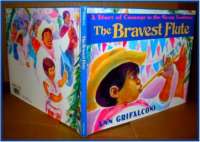
Follow the adventures of two children as they dodge a mosquito’s buzzing through the jungle and lush landscape.

Follow the adventures of two children as they dodge a mosquito’s buzzing through the jungle and lush landscape.

A young chief who had been protected by a hummingbird is killed by his jealous uncle and then transformed into a quetzal, symbol of freedom.

Recetas para convertir a las niñas en ranas y a los niños en murciélagos, fórmulas para desaparecer o para convertirse en algún animal.
Pociones para volar, para leer el futuro y hasta para el amor, hacen parte de este útil manual para jóvenes aprendices de magos. Se garantiza que todo funciona? siempre y cuando las recetas se sigan al pie de la letra, sin mezclar ingredientes ni enredar las palabras mágicas.

Hacer limpieza general puede descubrirnos un mundo. En el cuarto de mi madre -cuenta Bel- había un armario, dentro del armario había un cajón, dentro del cajón había una caja, dentro de la caja había un sobre, dentro del sobre había un montón de retratos, dentro de un retrato estaba Bisa Bea. Y así, de la mano del pasado y del futuro, Bel vivirá su presente.

In this evocative picture book, Mama, Papa, and six brothers and sisters live behind a fabric and thread store in downtown Guatemala City in the late 1950s. The narrator’s parents fled China during the Japanese invasion and, with a few neighbors, found refuge in Central America and opened their business. People come from all over to buy their bright fabrics and brilliant thread for weaving and making clothes. Author and artist Amelia Lau Carling depicts an almost magical kingdom where Chinese, Guatemalan, and Native cultures meet in harmony, where children can play and learn about all the different peoples who bring the city to vibrant life.
 Back in the earliest memories of the world, the God of the Night ruled the skies, but his reign as sun was ended by the jealousy of the God of the Wind. The ancient gods’ struggle for supremacy raged for ages, until the creation, by sacrifice of the fifth and final sun. “An unusual book that should do much to illuminate the legends of an important ancient culture.” — Kirkus Reviews
Back in the earliest memories of the world, the God of the Night ruled the skies, but his reign as sun was ended by the jealousy of the God of the Wind. The ancient gods’ struggle for supremacy raged for ages, until the creation, by sacrifice of the fifth and final sun. “An unusual book that should do much to illuminate the legends of an important ancient culture.” — Kirkus Reviews

The Caldecott Honor-winning author of The Village of Round and Square Houses offers an inspirational tale, featuring her own exuberant illustrations, about a brave Mayan boy who leads his village’s New Year’s Day parade, even though he is weak and hungry.

A polar bear reassures a cub by describing what a polar bear is and does, and promising to lovingly teach such necessary skills as hunting and walking securely on ice.